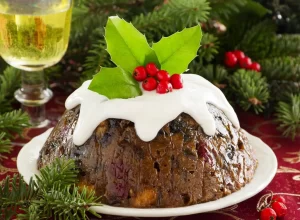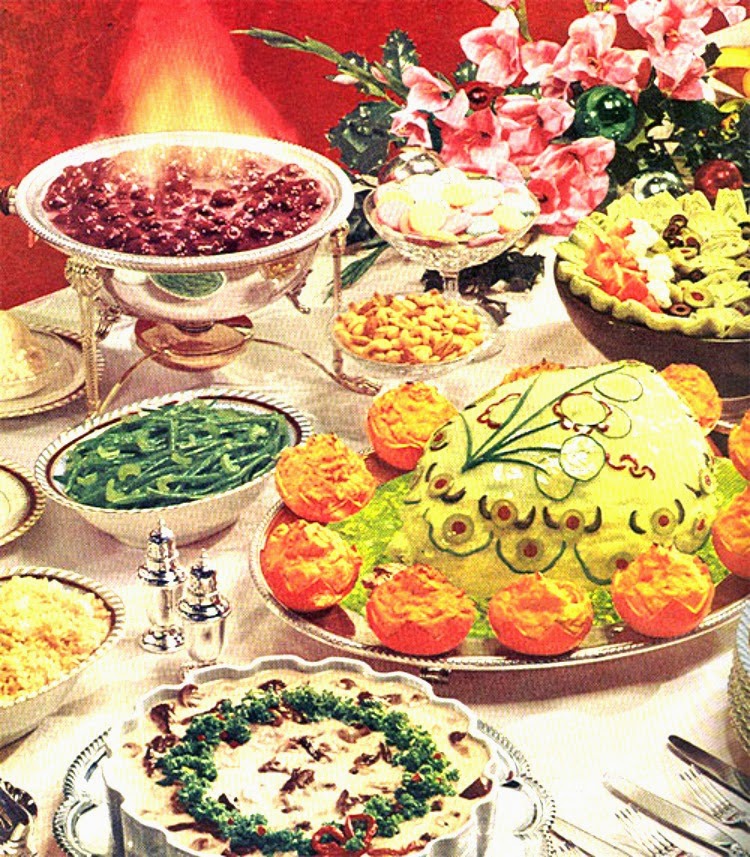Ghost of Christmas foods past
Besides the presents and the decorating, Christmas is also well known for the feast that accompanies the day. The various foods we eat on Christmas such as gingerbread and candy canes always put us in the right mood for the holiday, but what did people in past eras eat to get them into the Christmas spirit?
Figgy Pudding
Nowadays, figgy pudding is most notable for being a lyric in the Christmas song “ We Wish You a Merry Christmas”, other than that, it remains a forgotten dessert for the holidays. Despite the name, figgy pudding doesn’t contain figs or pudding, and, in fact, started out as a meatier dish than most would expect. The original recipe was a mixture of spices, fruits, vegetables, grains and of course, meats, all stuffed together into an animal stomach and intestines. In the 15th century the recipe had been tweaked and had finally been given a name, “plum pudding”(https://www.history.com/news/the-holiday-history-of-christmas-pudding ). The plum refers to the practice of drying fruits and vegetables, as these dried foods replaced the various meats, the dish made its way from savory to sweet. Today the dish still remains as a sweeter dessert and, despite being relatively unknown in America, it is still eaten on Christmas Day within the UK.
Fruitcake

Despite being unpopular, fruitcake finds itself constantly being used in fictional pieces poking fun at the “rock-like” Christmas dessert. From shows such as “Pee-Wee’s Playhouse” and “Golden Girls” to video games such as “The Sims” and “Terraria”, everyone has taken their jabs at insulting fruitcake for various reasons. Whether it be its digestive flavor or brick-like texture, fruit cake proves to be a widely hated dessert. (https://tvtropes.org/pmwiki/pmwiki.php/Main/EveryoneHatesFruitCakes). Fruitcake first started as an older version of an energy bar. Filled with an assortment of fruits and leaves paired with honey, wine and barley, fruitcake was used to keep up the energy of ancient Roman soldiers in battles. The more recognizable modern version of fruitcake appeared in the middle ages and was wheat mixed with nutmeg, cinnamon cloves, and a variety of spices. The recipe spread to multiple countries such as Italy and Germany and reached its height of popularity around the 19th century, becoming a popular dish for special occasions, one of which was Christmas. No one truly knows what happened for fruitcake to become as universally hated as it is today. One theory is that it had been so mass produced due to how many people wanted it that the cakes themselves dropped in quality, creating the dry and hard image we have with fruitcake today (https://www.smithsonianmag.com/arts-culture/fruitcake-101-a-concise-cultural-history-of-this-loved-and-loathed-loaf-26428035/). We don’t know whether fruitcake will ever rise in public opinion but for now, it doesn’t seem so likely. Poor fruitcake.
Panettone
More popular than the other old foods on this list so far, Panettone can still find its way into homes during Christmas time. First starting as a staple of a traditional Milanese Christmas to the face of Italian baked goods, Panettone has had an interesting journey throughout history. The origin dates as far back as the late 1400’s. As the legend goes, a chef from Milan had been madly in love with a woman from an incredibly wealthy family, but he himself had come from a poor background. This meant that regardless of what the chef did, the Duke would never give his blessing for the two to get married. Desperate to be married, the chef came up with a plan to invent a new type of bread that would make him enough money in order to marry his lover. He mixed ingredients that no one had ever tried before and created the panettone bread, which was filled with candied fruits and zested lemons. The story ended with the entire town loving the bread, including the Duke who later gave the chef his blessing (https://thepanettone.com/the-panettone-history/?v=7516fd43adaa) The popular dish made its way to Italy, where baker’s eventually replaced the fruits with raisins. The county of Italy is now the main exporter of the treat, selling over 117 million cakes each year.
Christmas Goose

Many for Christmas have turkey as a centerpiece, if not, then probably ham, chicken, or beef, , not many eat the traditional Christmas goose anymore. At first the tradition was a worldwide phenomenon, but now this tried and true dish usually resides solely in Germany. Many think of it as a mystery how this main platter first began, but one popular tale includes Queen Elizabeth I. Legend has it she had eaten a whole goose, in celebration, once she had discovered her British fleet had defeated the Spanish Armada and then ordered her subjects to do the same during Christmas. The idea stuck and spread throughout Europe, yet only stuck for the long term in Germany for some unknown reason. Another popular theory for the main goose dish was that the idea had ties to the Christian religion. Between St. Martin’s Day, November 11, and Christmas, medieval Christians would fast. Before and after the fasting period they’d eat a large dinner consisting of goose as the main dish, which would explain its heavy ties with the holiday. (https://www.deutschland.de/en/topic/life/eating-christmas-three-traditional-german-dishes-for-december#:~:text=One%20legend%20has%20it%20that,to%20Germany%2C%20where%20it%20stuck.) Despite losing popularity, Germany sticks behind the Christmas goose, making the dish named “Weihnachtsgans” every holiday season.
Mince Pies
Once one of the most popular treats to have during Christmas, mince pies have made a name for themselves as being a more savory than sweet dessert dish. The name is derived from one of its main ingredients of minced meat. The meat ranged from mutton, rabbit, beef and pork.
The pies originally consisted of 13 ingredients, including the meat, to represent Jesus and his 13 disciples. To further the religious ties, the pies were meant to be shaped like a crib with a dough baby Jesus to sit on. Along with this the pies were also instructed to be eaten for the 12 days leading up to Christmas, as it was said to bring the person happiness for the next 12 months. As the superstitions surrounding the pies developed, so did the different names given to the holiday treat. The names ranged from “crib pies” referring to the crib shape, to “wayfarer’s pie”, as it was tradition to give a passing-by traveler one of these small desserts. Today, mince pies no longer contain the meaty ingredients they once did, but rather have more sweet fillings. Mince pies have been around since the 13th century and still make small waves today as in some countries kids leave out pies for Santa rather than milk and cookies. (https://www.walkersshortbread.com/the-history-of-mince-pies/#:~:text=Mince%20pies%20were%20first%20served,curing%2C%20smoking%20or%20drying%20it.)
Christmas foods today never fail to put us in the spirit of gift giving and decorating, somehow never failing to get us all in the Christmas mood. I wonder what foods today will be long forgotten in the future and only seen as relics in the past such as the unpopular olden foods of back then.


